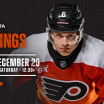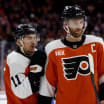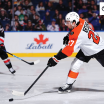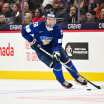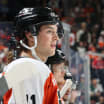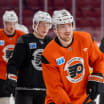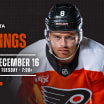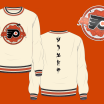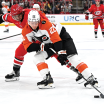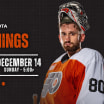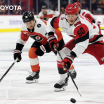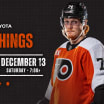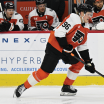Ever since Hockey Hall of Fame goaltender Jacques Plante, in 1959, became the first NHL goaltender to permanently don a face mask and the use of masks went from a curiosity piece to a necessity over the next decade-plus, the masks themselves evolved from strictly a utilitarian piece of equipment to a colorful expression of a goalie's personality, At first, splashes of color and/or team logos were added. Later, elaborate designs, thematic motifs and a full palette of colors were added; sometimes at the goalie's own behest, and quite often at the suggestion of professional mask designers.
Goalie Week: Memorable Masks
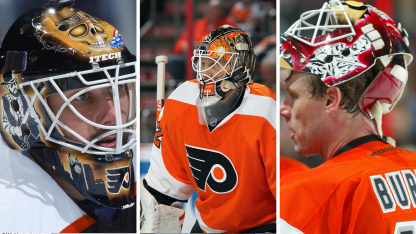
By
Bill Meltzer
philadelphiaflyers.com
Although there were still a few maskless goalies left by the time the Flyers entered the NHL in 1967 -- the last maskless goalie in the NHL was the Pittsburgh Penguins' Andy Brown in 1973-74 -- every goalie in Philadelphia's franchise history has worn a mask of one type or another. Through the end of the 2019-20 season, 60 goaltenders have appeared in at least one game for the Flyers in team history. The total excludes goalies who dressed as backups but never got into a single regular season game.
The following article is neither intended as an exhaustive history of every goalie mask in Flyers' history nor a list of only the most visually compelling ones. Rather, it's a chronological highlighting of their evolution, protective function and symbolic importance as well their visual appearance. Goalies whose masks are not mentioned include Phil Myre, Brian Boucher, Roman Cechmanek, Jeff Hackett, Sergei Bobrovsky and Ilya Bryzgalov.
Bernie Parent
Hockey Hall of Fame goaltender Bernie Parent is most immediately recognized for the mask he sported during his second stint with the Flyers (1973-74 to 1978-79): a white mask with Flyers logos emblazoned on the crown, the left temple and the right temple. The back of the mask had a protective shell (smaller than today's ones) between the straps in order to protect the wearer if he struck the back of his head.
It was while wearing this now-iconic mask style that Parent won back-to-back Vezina Trophies, Conn Smythe Trophies and the Stanley Cup championship in 1973-74 and 1974-75. Less famous are the more primitive and less protective masks that Parent wore during his first Flyers stint (1967-68 to midway through the 1970-71 season).
During the Flyers inaugural season, Parent wore a style colloquially called "the pretzel"; a simplistic fiberglass mask that fit flush to the wearer's face with straps attached to the sides and the crown. There was no protection for the back of the head. Later, Parent wore a mask that was basically an updated and slightly less primitive version of the mask that his childhood idol, Plante, first innovated. Before Parent came back to the Flyers, he switched styles while in Toronto and, during his year with the WHA's Philadelphia Blazers, sported a striking yellow-and-red design to match the team colors, with red "flames" rising up on the bottom half.
Doug Favell
The other half of the Flyers original goaltending tandem sported a wide array of masks and mask designs over the course of his career. In his early years with the Flyers, Favell, like Parent, sported a couple of different basic and relatively primitive fiberglass masks. However, on Halloween 1971, the fun-loving Favell carved out a niche in NHL history when he debuted a mask that was entirely spray-painted orange. Apropos both to the Flyers' colors and to Halloween itself. Favell's all-orange look was the first painted mask in league history, albeit not as visually or symbolically memorable as Gerry Cheevers' "stitches" face mask, which was the first custom-designed mask
During the latter part of Favell's Flyers tenure (1967-68 to 1972-73), he had a white mask with five large triangular orange accents alternating with the neutral white. Meanwhile, teammate Bobby Taylor sported essentially the same design as Favell's, except the colors were alternating black and white "rays".
Wayne Stephenson
The backup goalie to Parent for most of his Flyers career except when an injury to Parent pressed him into starting duty for most of the 1975-76 season, Wayne Stephenson wore a basic white mask at the beginning of his Philadelphia tenure (1975-76 to 1978-79). In 1977, however, he adopted one of the most visually striking masks of his era. Basically, the mask was modeled on the Flyers' road uniform: primarily orange, it had opposite-facing "Flyers logos" in black interlocked around the eyes with white accents to make the design pop even more. Stephenson's mask also later featured an orange-painted protective attachment at the bottom, which served as a first-generation neck guard.
Jerome Mrazek
A free-spirited type nicknamed "Moses" for his longish hair and elaborate mustache and beard, Mrazek made only one regular-season relief appearance (Feb. 7, 1976) during his time in the Flyers' organization, primarily playing in the minor leagues. However, despite the brevity of his Flyers' NHL playing career, Mrazek struck a memorable figure. His mask itself was plain and unremarkable except for the fact that, even by mid-70s standards, it wasn't particulary protective. What made it memorable was the fact that, even when wearing his mask, Mrazek's beard still jutted out from the bottom.
Pete Peeters
From the late 1970s to the mid-1990s, some NHL goalie took to wearing "birdcage" masks: standard helmets like position players wore, with facebars added. This was primarily for the sake of being more comfortable and less hot for the wearer. Some birdcages had a plastic neckguard added to the bottom.
Pete Peeters wore a full standard facemask (with a swirling black and orange paint design) with the AHL's Maine Mariners and during his early brief recalls to the Flyers. However, he more famously sported a helmet and face cage during his first stint with the team. It was in the helmet-and-cage with a neck guard that the rookie Peeters helped backstop the Flyers to a 35-game unbeaten streak and a trip to the Stanley Cup Final in conjunction with veteran Phil Myre. Peeters was named to the NHL All-Star Game in both 1979-80 and 1980-81.
Later, when Peeters returned to the Flyers for the 1989-90 and 1990-91 seasons, he used a full face mask -- white with four Flyers logos (crown, right temple, left temple, chin) -- that was fundamentally similar to styles that are still in use in the 2000s.
Other Flyers goalies who sported cages in the 1980s to the first half of the 1990s: Rick St. Croix, Bob Froese, Ron Hextall (part of his rookie season), Darren Jensen, Mark "Trees" Laforest, Wendell Young, Bruce Hoffort and Ken Wregget.
The team's final birdcage was perhaps the most memorable: Swedish goaltender Tommy Söderström favored a Jofa helmet with a massive, bubble-like cage that extended slightly past the earflaps on his helmet, and featured both black padding on the chin line and an attached full neck-guard. It was always easy to make out the goalie's facial features between the bars of the cage.
Pelle Lindbergh
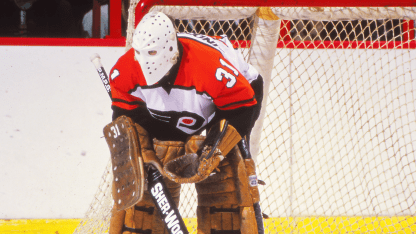
Even as a member of Hammarby's hockey program in Stockholm in the mid-1970s, several years before he was drafted by the Flyers in 1979, the late Pelle Lindbergh's mask paid homage to his idol, Bernie Parent. Not only did Pelle wear the same exact style of mask as Parent, he added Flyers logo decals in the same spots as Bernie's.
At the 1980 Olympics in Lake Placid, Lindbergh was dismayed when tournament officials told him that he had to place strips of white tape over his Flyers logos. He complied but later half-jokingly griped to Team USA goalie Jim Craig (whom Lindbergh befriended) that the latter was allowed to keep the shamrock decal on his mask while Pelle had to cover his Flyers logos.
During both his American Hockey League career with the Maine Mariners (for who wore uniform No. 1, also in tribute to Parent) and the Flyers (since No. 1 was retired in Parent's honor, he asked for No. 31), Lindbergh maintained the Parent-style mask, minus the logos. There were actually two different versions of Lindbergh's stark white fiberglass mask; the latter was created by famed mask designer Paul Harrison, and today is part of the Hockey Hall of Fame's collection. Lindbergh wore the latter one during his Vezina Trophy winning, Hart Trophy finalist season in 1984-85.
Lindbergh always took pride in his Parent-style mask, explaining in interviews that it was an extension of his personal journey in the sport. However, for a brief period of time, Lindbergh actually switched to a helmet-and-cage design.
When Lindbergh hit a severe slump in his second NHL season (1983-84), the Flyers briefly sent him to the AHL's Springfield Indians to regain his confidence and timing in a lower-pressure setting. During his short stint with Springfield, Lindbergh wore a helmet-and-cage with a "hornet" design on the helmet, modeled after the logo of Swedish newspaper, Expressen. Lindbergh wore it to change his luck and try to evoke a competitive, take-no-prisoners attitude like New York Islanders goalie Billy Smith.
After four games with Springfield, a more confident Lindbergh returned to the Flyers and re-donned his familiar white mask.
Ron Hextall
Flyers Hall of Fame goaltender Hextall featured at least six different mask designs during his two stint playing career with Philadelphia (1986-87 to 1991-92, 1994-95 to 1998-99) as well as wearing a helmet-and-cage for part of his rookie year. The most memorable design during his first stint featured a downward pointing orange arrow from the crown to the lower forehead. The mask was known as "The Puck Stops Here" motif, reminding shooters who was in charge.
Many years later, current Flyers goalie Brian Elliott featured a mask designed by Franny Drummond that was inspired by Hextall's famous arrow motif, except minus the arrow itself. Elliott, who grew up a fan of Hextall, wanted a homage to the arrow mask but not a direct copy. During the early 2010s, Michael Leighton also had a variation of the Hextall arrow design among the designs he wore.
During Hextall's second stint, he featured masks with various Philadelphia-inspired design elements such as Independence Hall, the Liberty Bell, and an illuminated Benjamin Franklin Bridge. Perhaps the most striking version featured a silvery Philadelphia skyline that covered roughly 2/3 of the mask along the bottom and the sides.
Garth Snow
The oft-feisty Snow, both in Philadelphia and elsewhere, favored a mask design prominently featuring a menacing yeti design against a solid background. In Philly, the abominable snowmen on either side stood against a black background and their claws stretched toward a Flyers logo on the chin.
John Vanbiesbrouck
During United States Hockey Hall of Fame inductee John Vanbiesbrouck's two-season stay with the Flyers in the latter part of his NHL career, "Beezer" featured an instantly recognizable mask design inspired by his nickname: an extensive "bee" motif set against a sparkly orange backdrop.
Antero Niittymäki
Flyers head coach Ken Hitchcock gave Finnish goaltender Niittymäki the nickname "Frank" because teammates called the player "Nitty" for short. The shortened version of the surname, in turn, reminded Hitchcock of infamous Prohibition era Chicago gangster Frank Nitti. Highly fictionalized versions of Nitti and Al Capone were villains on "the Untouchables," of which the hockey coach was a fan.
Soon, many Flyers fans and some teammates also took to calling the goaltender "Frank." The sobriquet became the genesis of his most famous mask design, featuring a Nitti-inspired vintage gangster in a shootout. He sported a couple of different variations on this theme.
Ray Emery
The late Ray Emery was a huge boxing fan as well as amateur boxer in his youth. During his first stint with the Flyers, Emery requested a mask design that incorporated some legendary boxers, including Muhammad Ali, Sugar Ray Robinson and Joe Frazier. On the back, the mask had a fictitious boxer familiar associated with Philadelphia: Rocky Balboa in Rocky IV.
Later, Emery had a mask that paid homage to the famous Tuskegee Airmen.
Robert Esche, Sean Burke and Rob Zepp
Friends and teammates with the Coyotes and the Flyers, Robert Esche and Sean Burke each sported mask designs during their careers that were reflective of their musical tastes.
Classic-rock loving Burke, who also is also a guitar aficionado, had masks during his career that honored the likes of Eric Clapton, Jimmy Page and Jimi Hendrix. Meanwhile, the more country-music influenced Esche's masks variously had likenesses of Waylon Jennings, Johnny Cash, Hank Williams Jr. and Kid Rock as well as a skull/Uncle Sam design at the crown.
Later, when Rob Zepp played for the Flyers in 2014-15, the chin portion of his mask featured his nickname, Zepper, written in the same font favored by the legendary Led Zeppelin fan. This wasn't simply a pun.
Zepp is legitimately a big fan of the band and a guitar hobbyist. On the back of the mask, in addition to a German flag, and his children's names, there was a sticker that said "yard sale"; an inside joke stemming not only from Zepp's much-traveled career but also from playing with buddies in a garage band dubbed "Yard Sale."
Mike McKenna
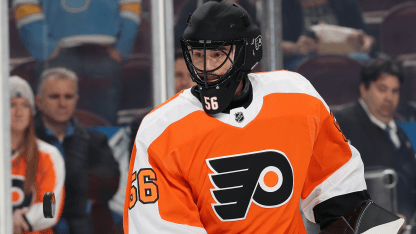
Speaking of well-traveled goalies, when veteran goalie Mike McKenna was claimed by the Flyers off waivers from the Vancouver Canucks on Jan. 2, 2019, the transfer came just two days after he'd been traded from the Ottawa Senators to the Canucks and one day after Vancouver placed him on waivers.
McKenna still had his Senators-themed mask upon his arrival with the Flyers. Temporarily, he had the Flyers equipment staff cover his mask entirely in black tape before he received a new design for the rest of his final pro season.
On-the-spot- color correction "solutions" such as these are not uncommon for goalies who've just been traded to or claimed by a different team until they can get new gear. Apart from tape on a mask or new tape on a goalie stick, equipment staff has used permanent marker to hastily change the color or pads. gloves or blocker accents. In some cases, however, a newly acquired goalie will simply keep things the same until he gets an updated mask and other equipment.
Apart from McKenna, other Flyers goalies who temporarily made use of a taped-up or white spray-painted mask right after their in-season acquisition by the Flyers included Leighton, Marty Biron. Frederic Chabot and a few others.
Steve Mason
Mason was fond of scary movies in general and the zombie subgenre in particular. During his Flyers career, Mason featured no fewer than four different zombie-themed masks.
One version featured zombified versions of famous Flyers of the past (including Bernie Parent, Bobby Clarke and Ron Hextall). Another featured his teammates as zombies, including Claude Giroux, Sean Couturier and Wayne Simmonds. In what proved to be his final NHL season, Mason had a zombified version of Winnipeg Jets teammates made for Halloween wear.
Michael Leighton, Steve Mason, Michael Neuvirth, Carter Hart
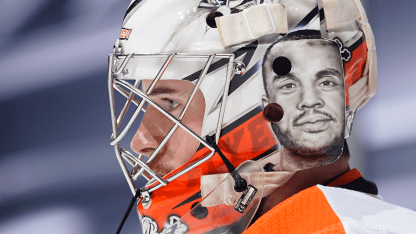
During the 2010s up through 2020, various Flyers goalies wore masks that paid tribute to famous Flyers players of the past, especially fellow goalies. Some of these masks were used regularly, while others made brief appearances.
Apart from the aforementioned Mason "famous Flyers zombified" mask, Leighton had a mask in 2010-11 that paid tribute to Broad Street Bullies era Flyers including Clarke and Dave Schultz. In 2017-18, Michal Neuvirth honored Lindbergh with a rendering of his likeness prominently displayed on his mask. This past season, one of Carter Hart's masks paid tribute to Emery.


